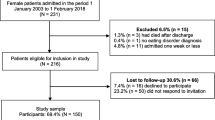Abstract
Objective: Dropouts are frequent among eating disorder (ED) patients, but less is known about their natural history. This paper assesses the outcome of outpatients who dropped out from a therapy programme and its possible causes. Material and Methods: From 1992 to 1994, we assessed 222 ED subjects. Psychiatrists expert in EDs evaluated these subjects by defining baseline parameters and diagnosis was made according to the 3rd revisioned edition of the Diagnostic and Statistical Manual of Mental Disorders. One hundred and twenty-eight subjects (57%) dropped out during the treatment. In 1997, we contacted them, reassessed the same baseline parameters and asked for a self-judgment about their social and clinical condition during the previous 2-5 years. Patients were classified as “improved” and “not improved” (stationary or worse) according to their social, physical and psychological condition. The relation between baseline condition and outcome was determined statistically. Results: Seventy-one percent of subjects were “improved” and no deaths were recorded. A significant correlation was found between “duration of illness” and no treatment following a dropout. Discussion: The high percentage of improvement among dropouts was unexpected. Shorter duration of illness and lack of specific therapy in the improved patients suggest the existence of a subset of ED patients with acute onset and a spontaneous tendency to improve. This point obviously requires further investigation.
Similar content being viewed by others
References
King M.: The epidemiology of eating disorders. Epidemiologia e Psichiatria Sociale, 7, 32–411, 998.
Lucas A.R., Beard C.M., O’Fallon W.N., Kurland L.T.: 50 year-trends in the incidence of anorexia in Rochester, Minn.: a population- based study. Am. J. Psychiatry, 148, 917–922, 1991.
Fichter M.M., Quadflieg N., Guntzmann A.: Binge eating disorders: treatment outcome over 6-years course. J. Psychosom. Res., 44, 385–405, 1998.
Strober M., Freeman R., Morrell W.: The long-term course of severe anorexia nervosa in adolescents: survival analysis of recovery relapse, and outcome predictors over 10–15 years in a prospective study. Int. J. Eat. Disord., 22, 339–360, 1997.
Keel P.K., Mitchell J.E.: Outcome in bulimia nervosa. Am. J. Psychiatry, 154, 313–321, 1997.
Herzog T., Hartmann A.: Psychoanalytically oriented treatment of anorexia nervosa. Methodology-related critical review of literature using meta-analysis methods. Psychother. Psychosom. Med. Psychol., 47, 299–315, 1997.
Turnbull S.J., Schmidt U., Troop N.A., Tiller J., Todd G., Treasure J.L.: Predictors of outcome for two treatments: short and longterm. Int. J. Eat. Disord., 21, 17–22, 1997.
Sullivan P.F., Bulik C.M., Fear J.L., Pickering A.: Outcome of anorexia nervosa: a case control study. Am. J. Psychiatry, 155, 939–946, 1998.
Fairburn C.G., Norman P.A., Welch S.L., O’Connor M.E., Doll H.A., Peveler R.C.: A prospective study of outcome in bulimia nervosa and the long-term effects of three psychological treatments. Arch. Gen. Psychiatry, 52, 304–312, 1995.
Herpetz-Dahlmann B.M., Wewetzer C., Remschmidt H.: The predictive value of depression in anorexia nervosa. Results of a 7-year follow-up study. Acta Psychiatr. Scand., 91, 114–119, 1995.
van der Ham T., van Strien D.C., van Engeland H.: Personality characteristics predict outcome of eating disorders in adolescents: a 4-year prospective study. Eur. Child. Adolesc. Psychiatry, 7, 79–84, 1998.
Sullivan P.F.: Mortality in anorexia nervosa. Am. J. Psychiatry, 152, 1073–1074, 1995.
Santonastaso P., Zanetti T., Sala A., Favaretto G., Vidotto G., Favaro A.: Prevalence of eating disorders in Italy: a survey on a sample of 16-year-old famale students. Psychother. Psychosom., 65, 158–162, 1996.
Cotrufo P., Barretta V., Monteleone P., Maj M.: Full-syndrome, partial-syndrome and subclinical eating disorders: an epidemiological study on female students in Southern Italy. Acta Psychiatr. Scand., 98, 112–115, 1998.
Saccomani L., Savoini M., Cirrincione M., Vercellino F., Ravera G.: Long-term outcome of children and adolescents with anorexia nervosa: study of comorbidity. J. Psycosom. Res., 44, 565–571, 1998.
Vandereycken W., Pierloot R.: Drop-out during in-patient treatment of anorexia nervosa: A clinical study of 133 patients. Br. J. Med. Psychol., 56, 145–156, 1983.
Kahn C., Pike K.M.: In search of predictors of dropout from inpatient treatment for anorexia nervosa. Int. J. Eat. Disord., 30, 237–244, 2001.
Baran S.A., Weltzin T.E., Kaye W.H.: Low discharge weight and outcome in anorexia nervosa. Am. J. Psychiatry, 152, 1070–1072, 1995.
American Psychiatric Association: Diagnostic and statistical manual of mental disorders, 3rd Edition Revised (DSM III R). Washington, DC, A.P.A. Press, 1987.
Fasanella I., Di Pietro G., Bellini O., Muscettola G.: Disturbi del pattern alimentare: evoluzione “naturalistica” in pazienti dropout. Rivista di Psichiatria, 31, 6–16, 1996.
Morgan H.G., Russell M.F.: Value of family background and clinical features as predictors of long-term outcome in anorexia nervosa: four-year follow-up study of 41 patients. Psychol. Med., 5, 355–371, 1975.
Palazzoli Selvini M., Cirillo S., Selvini M., Sorrentino A.M.: Ragazze anoressiche e bulimiche. Milano, Raffaello Cortina Editore, 1998.
Williamson D.A., Anderson D.A., Gleaves D.H.: Anorexia nervosa and bulimia nervosa: Structured interview methodologies and psychological assessment. In: Thompson K. (Ed.), Body image, eating disorders, and obesity: An integrative guide for assessment and treatment. Washington DC, American Psychological Association Books, 1996, pp. 205–223.
Reas D.L., Williamson D.A., Martin C.K., Zucker N.L.: Duration of illness predicts outcome for bulimia nervosa: a long-term follow- up study. Int. J. Eat. Disord., 27, 428–434, 2000.
Author information
Authors and Affiliations
Corresponding author
Rights and permissions
About this article
Cite this article
Di Pietro, G., Valoroso, L., Fichele, M. et al. What happens to eating disorder outpatients who withdrew from therapy?. Eat Weight Disord 7, 298–303 (2002). https://doi.org/10.1007/BF03324976
Received:
Accepted:
Published:
Issue Date:
DOI: https://doi.org/10.1007/BF03324976



